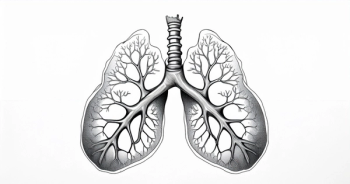
Peers & Perspectives in Oncology
- June II 2025
Amivantamab/Lazertinib Shows OS and PFS Benefits in EGFR-Mutated NSCLC
During a live event, Xiuning Le, MD, PhD, discussed updated intracranial efficacy, overall survival, and safety of amivantamab plus lazertinib in patients with EGFR-mutated non–small cell lung cancer.
Targeted Oncology: What were the outcomes of the MARIPOSA trial (NCT04487080) in patients with EGFR-mutated non–small cell lung cancer (NSCLC)?
Xiuning Le, MD, PhD: MARIPOSA is a global phase 3 study that enrolled a total of 1000 patients with EGFR [mutations] in the first line. The primary comparison is amivantamab [Rybrevant] plus lazertinib [Lacluze] vs the standard-of-care osimertinib [Tagrisso]. Each of these arms had over 400 patients. The primary end point for the study was progression-free survival [PFS], and one of the most important secondary end point was overall survival [OS]. The data presented at the 2023 European Society for Medical Oncology Annual Meeting showed statistically significant PFS benefit with an HR of 0.7 [95% CI, 0.58-0.85; P < .001], improving the [median] PFS to around 2 years [vs 16.6 months with osimertinib].1 For a patient with EGFR [mutation] upfront, the median PFS is no longer [less than] 18 months. It’s pushed to almost 24 months.
How did patients with high-risk features such as brain metastases respond to treatment?
For high-risk patients with either baseline brain metastasis or liver metastasis, or baseline detectable circulating tumor DNA, the HR was 0.72, also statistically significant [95% CI, 0.58-0.90; P = .004].2 For patients who have brain metastasis, it is almost unreasonable to not talk about intensification as osimertinib only gives over 1 year of PFS [vs 20.3 months with the combination]. In addition, TP53 mutation should be considered a high-risk factor.
FLAURA2 [NCT04035486] is a trial that showed CNS [central nervous system] benefit,3 but the FLAURA2 trial design didn't require the patient to get a brain MRI every 3 months. For MARIPOSA, the brain MRI at every 3 months was required. The intracranial PFS is a lot more accurate than [that of] FLAURA2. Nonetheless, I think both regimens have benefit in patients with CNS metastasis, so both should be considered. This is either untreated and asymptomatic or prior treated and stable [metastases]. The intracranial duration of response is always better than PFS, because its response for amivantamab/lazertinib is longer and [the median] hasn’t been reached [vs 24.4 months with osimertinib].4 We will probably see another comprehensive CNS update in the later part of the year for MARIPOSA.
Was there OS benefit with the combination regimen?
What were the most common mechanisms of resistance following this combination?
Data were reported about the resistance mechanism for the MARIPOSA trial.6 As expected, the MET-mediated resistance decreased significantly [vs osimertinib], and the EGFR resistance decreased significantly, [which is] just representing amivantamab as a bispecific antibody. We have to see what the resistance mechanism are that have increased. Currently, the data are not fully reported out.
What tolerability concerns are there with the combination?
For amivantamab plus lazertinib, the grade 3 or higher incidence is 75%, so the number of patients who have grade 3 toxicity will be significant.1 That’s not something that's neglectable. There are dose interruptions as high as 80% and then there are dose reductions [in 59%], and because it's a 2-drug regimen, often patients will stop amivantamab. We still don't have data on dose intensity, meaning how long a majority of the patients can get can receive amivantamab and still derive the PFS and OS benefit. I think the Janssen team needs to have that data available. Lazertinib behaved just like osimertinib; we know that it's not easy, but overall, we have many years of experience, so most patients and physicians can manage.
For amivantamab and lazertinib, amivantamab has high incidence of infusion reaction, skin rash, as well as paronychia. Those directly impact the patient's quality of life. If the patient stays on treatment for a prolonged time, peripheral edema, a MET on-target toxicity, becomes a [concern]. Beyond that, the venous thromboembolism [VTE] prophylaxis in the initial 4 months is something we haven't been able to get rid of. It’s still something needs to be done.
[Looking at] dose interruption vs time, overall, the adverse events happen in the first 4 months, and after that, patients have figured out how to manage their dermatological issues, and the dose is being adjusted, probably to a lower dose.7 After the initial 4 months, the VTE prophylaxis can be taken off, and often patients have a smoother ride after the initial active management.
Is the need for VTE prophylaxis a unique concern with this regimen?
It's only for amivantamab/lazertinib, and only upfront. Amivantamab plus chemotherapy doesn't need [VTE prophylaxis]. The lazertinib monotherapy approved in Korea also doesn't need it. Subcutaneous amivantamab may decrease the VTE incidence. We think, though no one knows, that there's some inflammation. It could have inflammation that is intravascular and generates a cytokine storm or something that makes the body tilted more towards clotting. The protocol was amended halfway based on the incidence they saw.
In the osimertinib single-agent arm, the VTE was around 5% to 7%, just like our patients with lung cancer. Before the protocol amendment, I believe the incidence was 17%, so it's increased. After prophylaxis, it came back down. If there's a VTE, it happens in the first 4 months [median, 84 days].1 [After] the protocol got amended, VTE went down to the baseline level. In PALOMA-3 [NCT05388669] with the subcutaneous [amivantamab], it decreased.8 But PALOMA-3 also had a portion of the patients protected on anticoagulation.
DISCLOSURES: Le previously reported consulting/advisory role for Eli Lilly, EMD Serono, AstraZeneca, Spectrum Pharmaceutics, Novartis, Regeneron, Boehringer Ingelheim, Hengrui Therapeutics, Bayer, Teligene, Taiho, Daiichi Sankyo, Janssen, Blueprint Medicines, Sensei Biotherapeutics, SystImmune, ArriVent, Abion, and AbbVie; institutional research funding from Eli Lilly, EMD Serono, ArriVent, Dizal, Teligene, Regeneron, Janssen, ThermoFisher, Takeda, and Boehringer Ingelheim; travel support from EMD Serono, Janssen, and Spectrum Pharmaceutics, and stock options from BlossomHill.







































